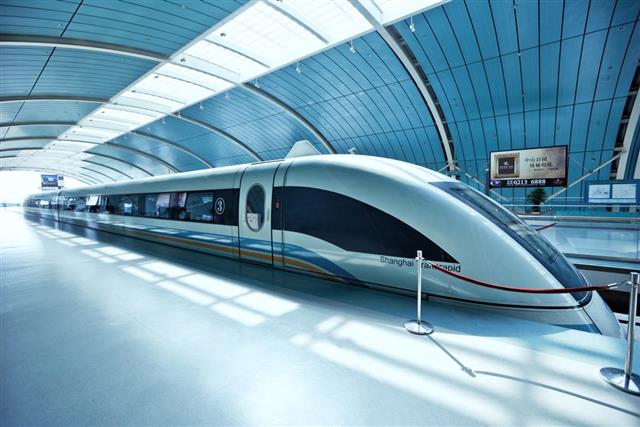
While the amazing speed that maglev trains boast of make them seem an apt solution for our transport woes, only a proper evaluation of their advantages and disadvantages can help us get a clear picture about the feasibility of putting them to use.
On December 2, 2003, the Japanese JR-maglev became the fastest non-conventional train in the world by clocking an impressive speed of 361 mph. By pulling off this amazing feat, the three-car Japanese maglev edged out the French TGV (Train à Grande Vitesse)―the fastest conventional train with the highest speed of 357.2 mph―by a margin of 3.7 mph. The Shanghai maglev train―pitted to be the most successful maglev in the world―covers a distance of 19 miles in 7 minutes and 20 seconds, with a top speed of 268 mph and an average speed of 160 mph.
The seemingly impossible speeds that the maglevs boast of, hint at the fact that we have come a long way from the traditional steam engines to sleek, super-fast trains. But is it really a feasible option to go for a maglev network in a country like the United States?
Maglev Trains
The guideway is made up of magnetized coils, which repel the magnets that are attached beneath the cars and makes them levitate around 0.39 to 3.93 inches above the guideway. When the power is sent to these coils, it results in the formation of a unique magnetic field, which, in turn, moves the maglev.
These trains resort to two different types of magnetic levitation: (i) electrodynamic suspension (EDS), wherein the repulsive force of magnets comes into play, and (ii) electromagnetic suspension (EMS), wherein the attractive force of magnets is involved.
Advantages and Disadvantages
Advantages of Maglevs
- The foremost advantage of maglev trains is the fact that it doesn’t have moving parts as conventional trains do, and therefore, the wear and tear of parts is minimal, and that reduces the maintenance cost by a significant extent.
- More importantly, there is no physical contact between the train and track, so there is no rolling resistance. While electromagnetic drag and air friction do exist, that doesn’t hinder their ability to clock a speed in excess of 200 mph.
- Absence of wheels also comes as a boon, as you don’t have to deal with deafening noise that is likely to come with them.
- Maglevs also boast of being environment friendly, as they don’t resort to internal combustion engines.
- These trains are weather proof, which means rain, snow, or severe cold don’t really hamper their performance.
- Experts are of the opinion that these trains are a lot safe than their conventional counterparts as they are equipped with state-of-the-art safety systems, which can keep things in control even when the train is cruising at a high speed.
Disadvantages of Maglevs
While the advantages of Maglev Train System may seem quite promising in themselves, they are not enough to overshadow the biggest problem with the maglev trains: the high cost incurred on the initial setup. While the fast conventional trains that have been introduced of late, work fine on tracks which were meant for slow trains, maglev trains require an all new set up right from the scratch. As the present railway infrastructure is of no use for maglevs, it will either have to be replaced with the Maglev System or an entirely new set up will have to be created―both of which will cost a decent amount in terms of initial investment. Even though inexpensive as compared to EDS, it is still expensive compared to other modes.
If the advantages and disadvantages of these trains are pitted against each other, it can be a bit difficult to come to a concrete conclusion. While the high cost of initial set up is something that a developed nation like the United States won’t have to worry about, the fact that the entire infrastructure has to be replaced with a new one will be something that will have the experts in a catch-22 situation. But obviously, we will have to do away with their disadvantages if we are to invest in maglev trains. If the commercial success of the Shanghai maglev train is to be taken into consideration, these trains can be surely considered the transport system of the future.
